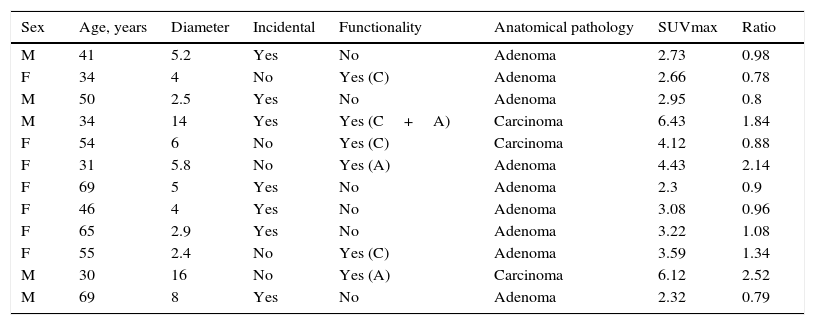Our purpose was to assess the utility of 18F-fluorodeoxyglucose positron emission tomography (18F-FDG PET) in pre-surgical characterization of adrenal masses. These masses were incidentally discovered in non-oncologic patients or during the study of endocrine hormone overproduction. These nodular lesions showed nonspecific or suspicious radiological features in the imaging tests routinely performed (CT and/or MRI).
Patients and methodsThis is a cross-sectional and prospective study in 12 patients with adrenal masses which were radiologically non-specific or suspicious for malignancy before adrenalectomy. An 18F-FDG-PET was made and quantitative FDG uptake (SUVmax) in the adrenal region (adrenal SUVmax) and liver (liver SUVmax), and the ratio SUVmax adrenal/liver was calculated. These parameters were related to the pathological findings. We evaluated the accuracy of the test by receive operating curves (ROC).
ResultsThe ROC to discriminate between benign and malignant lesions showed that the SUVmax was a better parameter than size or SUVmax adrenal/liver ratio. Using a SUVmax cutoff value ≥3.1, sensitivity, specificity, positive and negative predictive value of the test were 100, 67, 50 and 100%, while a SUVmax adrenal/liver ratio ≥1.8 showed a sensitivity, specificity, positive and negative predictive value of 67, 100, 100 and 90%, respectively. The presence of a SUVmax adrenal/liver ratio ≥1.8 showed a statistically significant association with carcinoma occurrence.
Conclusion18F-FDG-PET may be useful in the characterization of nonspecific or suspicious adrenal masses discovered in patients without a previous history of cancer. Its use in some cases could avoid unnecessary interventions.
Valorar la utilidad de la 18F-fluorodeoxyglucose positron emission tomography (18F-FDG-PET, «tomografía de emisión de positrones con 18F-fluorodesoxiglucosa») en la caracterización prequirúrgica de masas suprarrenales, en pacientes no oncológicos, cuyas características en TAC y/o RMN fueran inespecíficas o que presentaran alguna característica de malignidad.
Pacientes y métodosEstudio transversal y prospectivo en 12 pacientes con masa suprarrenal radiológicamente inespecífica o sospechosa de malignidad que iban a ser adrenalectomizados. Se realizó una 18F-FDG-PET calculándose la captación cuantitativa máxima de FDG (SUVmáx) en adrenal (SUVmáx adrenal) e hígado (SUVmáx hígado) y el cociente SUVmáx adrenal/hígado, que se relacionaron con el resultado anatomopatológico, evaluándose la fiabilidad de la prueba mediante receive operating curves (ROC, «curvas de rendimiento diagnóstico»).
ResultadosLas curvas ROC para discriminar entre lesiones benignas y malignas mostraron que el SUVmáx era mejor parámetro que el tamaño o el cociente entre SUVmáx adrenal/hígado. Utilizando como punto de corte un valour de SUVmáx≥3,1 los valores de sensibilidad, especificidad, valour predictivo positivo y negativo de la prueba fueron 100, 67, 50 y 100%, respectivamente, mientras que un cociente SUVmáx adrenal/hígado≥1,8 mostró una sensibilidad, una especificidad, un valour predictivo positivo y un valour predictivo negativo de 67, 100, 100 y 90%, respectivamente. La presencia de un cociente SUVmáx adrenal/hígado≥1,8 mostró una asociación estadísticamente significativa con la aparición de carcinoma.
ConclusiónLa 18F-FDG-PET puede ser de utilidad en la caracterización de masas suprarrenales inespecíficas o sospechosas, descubiertas en pacientes no oncológicos. Su uso en algunos casos podría evitar intervenciones innecesarias.
Artículo
Comprando el artículo el PDF del mismo podrá ser descargado
Precio 19,34 €
Comprar ahora








